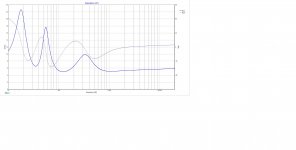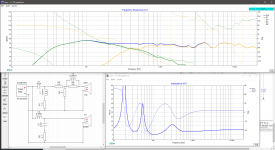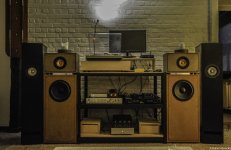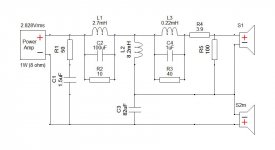Hi
I am trying to build my first WAW with passive crossover. The woofer will be Peerless 830869 which will be housed in a MLTL cab. The full range will be MA Alpair 10p and will be housed in mid-tunnel. Desired crossover point is around 400 Hz. Baffle will be 9.8 inches wide hence baffle-step will be around 465 hz.
I am attaching the dxo file along with some pictures. I used Xsim and Jeff Bagby's response modeller for my design. Please have a look and help me to make it better. Thanks in advance.
I am trying to build my first WAW with passive crossover. The woofer will be Peerless 830869 which will be housed in a MLTL cab. The full range will be MA Alpair 10p and will be housed in mid-tunnel. Desired crossover point is around 400 Hz. Baffle will be 9.8 inches wide hence baffle-step will be around 465 hz.
I am attaching the dxo file along with some pictures. I used Xsim and Jeff Bagby's response modeller for my design. Please have a look and help me to make it better. Thanks in advance.
Attachments
I would do it different. Mainly use the cr to do the baffle step, and tame the peaks a bit up in the 3K to 15K region. This is a raw id (10 min messing arround), this needs fintuning off course.
And i saw that you did not count for the time alignment on the baffle, i don't think you do that in your box (or assumed you don't) and guessed that you put both drivers as close as possible (which is often the best)
This is my result including the file. Just as example and without any guarantees or responsabilities off course...
And i saw that you did not count for the time alignment on the baffle, i don't think you do that in your box (or assumed you don't) and guessed that you put both drivers as close as possible (which is often the best)
This is my result including the file. Just as example and without any guarantees or responsabilities off course...
Attachments
baffle-step will be around 465 hz
Which ideally means XO can be used for any BSC if between 465 and 330 Hz.
Halcyon has A10p at 400 Hz, you can look at that one for reference. waxx uses A10.3 which is a bit different but his is worth looking at as well.
I know the appeal of a passive XO, but would look to biamp.
dave
waxx uses A10.3 which is a bit different but his is worth looking at as well.
This sim is with the 10P (the data the OP provided).
I use a totally different crossover with my 10.3, a serial 1st order at 250Hz with some notch filters and a zobel (to run from a tube amp). And my woofer is a 10" Scanspeak 26W/8534G00. I did a passive to run all from my tube amplifier. I like bass from tube amps, it got a special sound that no solid state can give on bass. Active would mean i need to get a active crossover and another tube amp, which would cost me a lot. But it has also advantages, that is true.
Attachments
And i saw that you did not count for the time alignment on the baffle, i don't think you do that in your box (or assumed you don't) and guessed that you put both drivers as close as possible (which is often the best)
I did put a delay in the crossover and i did that on woofer driver (0.86 inch). As far as i know, one has to put delay to the driver, voice coil of which is further away from measuring microphone( Correct me if i am wrong).
The standard method is to measure with proper timing, then do not adjust delay in the simulator.As far as i know, one has to put delay to the driver, voice coil of which is further away from measuring microphone( Correct me if i am wrong).
... Which doesn't always work - REW will automatically centre the impulse peak on T=0.
The best way of incorporating the different time-of-flight delays is this:
- Measure one driver
- Measure the other
- Measure both drivers in parallel. No crossover. If a dome tweeter is in use, run the sweep from 1kHz upwards, and be sensible with levels.
- Import both drivers into XSim, and put them in parallel in the circuit.
- Adjust relative delays until the XSim curves look exactly like the "both drivers in parallel" measurement.
Working on my most recent project, the woofer had a breakup peak at 8kHz, with an associated phase shift, which resulted in a very particular response curve when adding the mid-high driver in parallel.
Playing with the delay a little got things nailed down perfectly, and then I was 100% confident that the simulations would be correct. Of course, having the crossover in the <500Hz range generally means the time alignment isn't so critical, but it's good practice to do things in this way.
Chris
The best way of incorporating the different time-of-flight delays is this:
- Measure one driver
- Measure the other
- Measure both drivers in parallel. No crossover. If a dome tweeter is in use, run the sweep from 1kHz upwards, and be sensible with levels.
- Import both drivers into XSim, and put them in parallel in the circuit.
- Adjust relative delays until the XSim curves look exactly like the "both drivers in parallel" measurement.
Working on my most recent project, the woofer had a breakup peak at 8kHz, with an associated phase shift, which resulted in a very particular response curve when adding the mid-high driver in parallel.
Playing with the delay a little got things nailed down perfectly, and then I was 100% confident that the simulations would be correct. Of course, having the crossover in the <500Hz range generally means the time alignment isn't so critical, but it's good practice to do things in this way.
Chris
It shouldn't. REW, like most others requires a loopback reference which is a dual channel technique. Some measurement programs like HolmImpulse can do timing with only one channel.... Which doesn't always work - REW will automatically centre the impulse peak on T=0.
Crossover is 350 to 400 hz . Driver centre to centre distance is 11.25 inches (8 inch woofer and 5 inch full range). May be quarter wavelength distance is going through in Dave's mind.. Just my assumption.
All your comments are immensely helpful. No measuring microphone is available here ( at least when I checked last). I took help from Bagby's response modeler.
Here are two series XO that I came up with. Second one is derived following Halcyon XO created by Curt Campbell .....as suggested by Dave. Phase is looking better in the first one. Guys please have a look and tell me what do you think. Parallel XO that i posted earlier needs more components than the two series XO.
Attachments
-
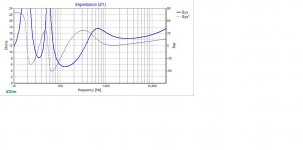 P+ 10P series XO 2nd impedance.jpg70.6 KB · Views: 126
P+ 10P series XO 2nd impedance.jpg70.6 KB · Views: 126 -
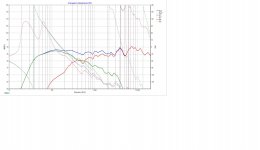 P+ 10P series XO 2ndFR and phase.jpg197.2 KB · Views: 127
P+ 10P series XO 2ndFR and phase.jpg197.2 KB · Views: 127 -
P+ 10P Series 2.dxo60.1 KB · Views: 51
-
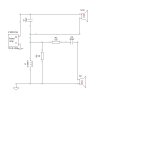 P+ 10P series XO components.jpg34.8 KB · Views: 128
P+ 10P series XO components.jpg34.8 KB · Views: 128 -
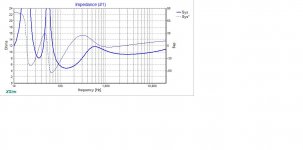 P+ 10P series XO impedance.jpg70.5 KB · Views: 129
P+ 10P series XO impedance.jpg70.5 KB · Views: 129 -
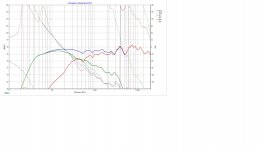 P+ 10P series FR and phase.jpg198.6 KB · Views: 123
P+ 10P series FR and phase.jpg198.6 KB · Views: 123 -
P+ 10P Series.dxo59.6 KB · Views: 45
-
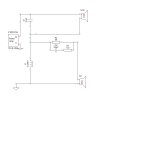 P+ 10P series XO 2nd components.jpg34.6 KB · Views: 69
P+ 10P series XO 2nd components.jpg34.6 KB · Views: 69
11.25” -> 300 Hz quarter wave at 300 hz, even if the drivers are on the same flat baffle, th edriver sare essential coincident.
A time delay is invoked to move a “tweeter” back in time, so that (at one point in space) the drivers are less than a quarter wavelength. At tweeter XO frequencies a quarter wavelength is quite small, with a WAW we can achieve that quarter wavelength spacing with nothing fancier than just getting them close. And the “point in space” becomes huge.
I suspect that at the frequencies you are XOing at the delay will only be needed to compensate for what an XO > 1st order does to the timing.
dave
A time delay is invoked to move a “tweeter” back in time, so that (at one point in space) the drivers are less than a quarter wavelength. At tweeter XO frequencies a quarter wavelength is quite small, with a WAW we can achieve that quarter wavelength spacing with nothing fancier than just getting them close. And the “point in space” becomes huge.
I suspect that at the frequencies you are XOing at the delay will only be needed to compensate for what an XO > 1st order does to the timing.
dave
At this point you probably actually have to build it and listen.
I tend to prefer first order series if it can be gotten away with, but it does not always work out (the series passive on our A12pw looked good, did a few things better than the higher order parallel but in the end we chose the latter.
dave
I tend to prefer first order series if it can be gotten away with, but it does not always work out (the series passive on our A12pw looked good, did a few things better than the higher order parallel but in the end we chose the latter.
dave
Which type of inductor I should choose? One more thing to ask.. Has anyone measured Alpair 10P? How different or close the measurement is to the published FR and T/S parameters?
So which crossover I should go forward with?
This question illustrates one of the hidden costs of working out an XO for a new box…
The answer is, all the ones that look promising and choose the one that works best for you.
You end up with a whole bunch of passive parts that cost a fair amount of money.
With an active system any extra parts are all much-much cheaper, and you only have to buy the XO and an extra amp. And for bass, some of the budget Class D amps work fine and can help keep the cost down. If you design to use a PLLXO XO cost approachs zero.
A little diy, a PPLXO, one of those amps, one could get away with <$100.
dave
- Home
- Loudspeakers
- Full Range
- Passive Crossover For my First WAW


